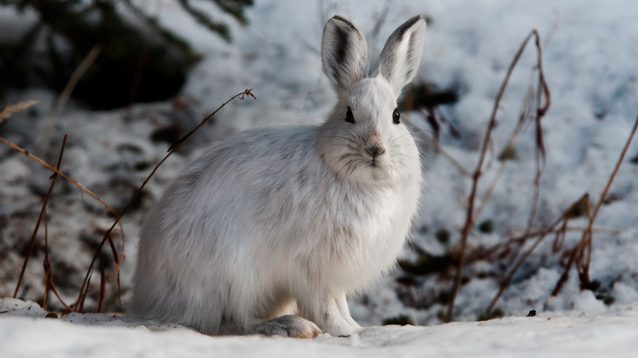Color-changing Hares in Southern Edge of Range Are More Vulnerable to Phenological Mismatch


2014-15 Global Change Fellow, Marketa Zimova, is lead author on a SE CASC supported publication, Local climate determines vulnerability to camouflage mismatch, published in Global Ecology and Biogeography.
Some of the challenges that plants and animals face as a result of changing climate are potential disconnects between the timing of important life-cycle events and the optimal environmental conditions to which the species have adapted. These phenological mismatches can disrupt relationships between animals and the resources they depend on for food, for instance, and in the absence of adaptation lead to population declines. A recently published article supported by the Southeast CASC, Local climate determines vulnerability to camouflage mismatch in snowshoe hares, summarizes research on this common North American mammal that changes its coat color seasonally in order to maintain camouflage against snowy backgrounds. The goal of the research was to quantify the environmental drivers of variation in snowshoe hare molt phenology in order to assess the species’ vulnerability to current and future mismatch in seasonal camouflage.
Former Global Change Fellow, Marketa Zimova and research team analyzed data from 448 remote camera trap sites that resulted in more than 5,500 photographs of snowshoe hares from three regional monitoring studies in North America: the Canadian Rockies, the San Juan Mountains in Colorado, and northern New England over seven years, 2010-2017. They incorporated geospatial and high-resolution climate data and estimated occurrence of camouflage mismatch between hares’ coat color and the presence or absence of snow.
They determined that spatial and temporal variation in molt phenology depended on local climate conditions more so than on other geophysical factors such as latitude. First, hares in colder, snowier areas molted earlier in the fall and later in the spring. Hares also exhibited phenotypic plasticity in molt phenology – the ability to shift molt progression in response to environmental conditions – based on annual variation in temperature and snow duration, especially in the spring. However, despite this local adaptation in molt phenology, snowshoe hares were not able to completely avoid camouflage mismatch. Primarily, white hares on dark, snowless background were the most common during low-snow years but only in regions characterized by shallow, short-lasting snowpack.
The research demonstrates that long-term climate and annual variation in snow and temperature determine coat color molt phenology in snowshoe hares. In most areas, climate change leads to shorter snow seasons, but the occurrence of camouflage mismatch varies across the species’ range with highest mismatch experienced by populations distributed along the southern edge of the species’ range. These results underscore the population-specific susceptibility to climate change-induced stressors and the necessity to understand this variation to prioritize the populations most vulnerable under global environmental change.
This work was supported by several other funding sources, including the Northeast Climate Adaptation Science Center.
Citation: Zimova, M, APK Sirén, JJ Nowak, AM Bryan, JS Ivan, TL Morelli, SL Suhrer, J Whittington, LS Mills. Local climate determines vulnerability to camouflage mismatch in snowshoe hares. Global Ecol Biogeogr. 2019; 00: 1– 13. https://doi.org/10.1111/geb.13049
- Categories:
